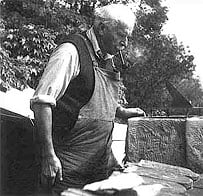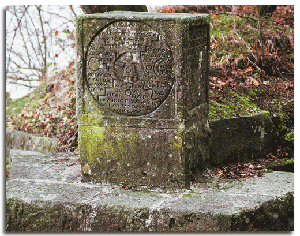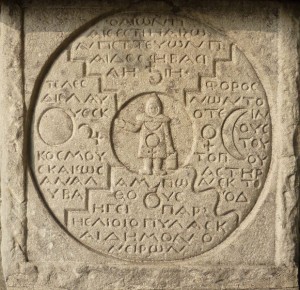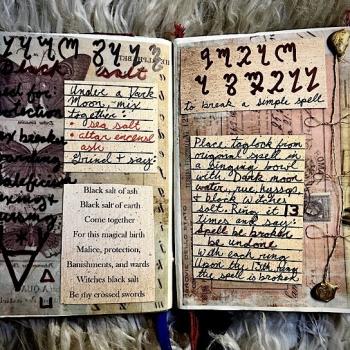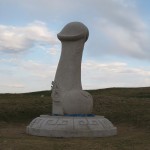Recently, I discovered a great blog at Witches and Pagans called Baring the Aegis: Hellenismos by Elani Temperance on Greek reconstructionist spirituality. Her full blog can be found here. Two posts in particular caught my attention, both on the practice of libations: “Sponde and khoe; the practice of liquid sacrifices” and “Khernips and libations; two videos on Hellenic ritual”. The videos which Elani made are both beautiful and instructive. I recommend watching them, especially the second one on libations (below).
One thing I like about Elani’s discussion of libations are the little details that help to sacralize the practice: like stepping away from the altar before “processing” back to it, and shifting the vessel from the right to the left hand before pouring the libation.
Libations are a practice that I discovered when I first started practicing Paganism. I like libations because, since they are liquid, they are absorbed by the ground, and you are not left with food lying about as with other offerings of foodstuffs. But more than that, there is something visceral about pouring a liquid; it evokes all the sensations that I associate with running water: rivers, waterfalls, showers, and long thirsty draughts of water.
On my recent visit to the University of Pennsylvania Museum of Anthropology and Archeology in Philadelphia, I saw an Egyptian offering table. The channel allows libations to run off the surface.
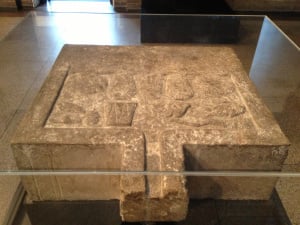
This table resembled a similar one I saw at the Rosicrucian Egyptian Museum several months ago in San Jose, California. This one came from the Ptolemaic period of Egypt. The items carved on the surface are “activated” by pouring liquid on the surface from special hs jars.
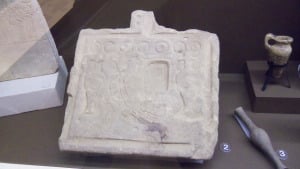
When I saw this, I became fascinated with idea of making an altar with a prayer carved into stone over which water could poured to “activate” the prayer, similar in some ways to Tibetan prayer wheels.
I’ve been fantasizing about a libation stone of my own. I just need to figure out if I want to pay someone to make this (who?) or learn to carve stone myself. I’m actually considering learning to carve it myself. Lupa recently wrote at No Unsacred Place about the spiritual practice of “getting your hands dirty”, combining hard work and the outdoors, literally digging your hands into the environment. What’s that Buddhist saying? “Before enlightenment — chop wood, carry water. After Enlightenment — chop wood, carry water.” Carving stone seems like a great way to “get my hands dirty”.
I recently completed several biographies of Jung and was interested to learn that Jung carved stone as a spiritual practice. He wrote that through his writing he found a way to put the contents of his unconscious on a “solid footing”, but still he was unsatisfied. “Words and paper, however, did not seem real enough to me; something more was needed. I had to achieve a kind of representation in stone of my innermost thoughts …” And so, in 1922, he began building a stone house for himself on the lake at Bollingen. The building, or the “Tower”, went through several phases over the decades, a process that Jung associated with the evolution of his Self. Jung’s Self took the form of Philemon in his practice of active imagination. But in the material world, it took the form of the Tower at Bollingen.
At Bollingen, there was no electricity and no running water. Jung would chop wood, pump and carry water, and cook for himself. (He is reported to have been an excellent cook.) “These simple acts make man simple,” Jung wrote, “and how difficult it is to be simple.” Chop wood, carry water.
In 1950, Jung ordered a triangular cornerstone, but the quarry sent a square block that was a perfect cube. When he saw it, Jung wanted it and decided to make a monument with it. In celebration of his 75th birthday, Jung carved the stone below as a “thanks offering” (as he called it) and as an “explanation” of the Tower.
Jung carved on multiple sides of the stone, borrowing his text from alchemical writings, Heraclitus, the Mithras liturgy, and Homer. The inscription on the side depicted above is Greek and reads, in part:
“This is Telesphoros, who roams through the dark regions of this cosmos and glows like a star out of the depths. He points the way to the gates of the sun and to the land of dreams.”
(Telesphoros was the dwarf son of Aesclepius, the Greek god of healing.)
So Jung has inspired me. I don’t plan to build a tower. But I am seriously considering learning some basic stone carving. I have been designing my “libation altar” in my mind. On the surface of the stone, I want to have a raised text that is taken from the second chapter of the Book of Hosea:
Then the earth will answer
with the honey,
and the wine,
and the oil.
And on the front I would put the Hebrew word, Jezreel:
יִזְרְעֶֽאל׃
which is a play on words from Hosea which literally means “God sows”.
The Book of Hosea has always fascinated me, especially chapter 2. It is one of the oldest books of the Old Testament, dating perhaps to the 8th century BCE, and is a polemic against the fertility cult of Ba’al. What is interesting is that, in this chapter, Yahweh describes himself also as a fertility god. The story can be read on multiple levels, as a story about a prophet that marries a (sacred?) prostitute, a story about Yahweh and his metaphorical wife Israel, or a story about Yahweh and his mythical wife Asherah and her lover Ba’al. The text reads:
“In that day, I will answer,” says the LORD. “I will answer the heavens [as they plead for clouds]. And the heavens will answer the earth [with rain]. Then the earth will answer with grain, and the wine [grapevines], and the oil [olive trees]. And they in turn will answer, ‘Jezreel’—‘God sows!’
(Hosea 2:21-22).
On the back side, I would put this text from Genesis 28:
Jacob took the stone
and set it up as a pillar
and poured oil on top of it.
The text comes from the story of Jacob’s vision of the ladder:
“Then Jacob awoke from his sleep and said, “Surely the Lord is in this place, and I did not know it.” And he was afraid and said, “How awesome is this place! This is none other than the house of God, and this is the gate of heaven.” So early in the morning Jacob took the stone that he had put under his head and set it up for a pillar and poured oil on the top of it. He called the name of that place Bethel …”
The text is Biblical evidence of a practice of worship of standing stones (massboth) which was common in Palestine, but condemned in other parts of the Bible, and usually coincided with the worship of Asherah poles or trees (Hosea 3:4; Hosea 10:2; Ex. 34:13; Deut. 7:5; Deut. 12:3; 1 Kings 14:23; 2 Kings 10:17; 2 Kings 18:14; 2 Kings 23:14; 2 Chron. 14:13; Jer. 3:9; Micah 5:13).
Then on the right and left sides of the altar I would put this text taken from the Canaanite Ba’al cycle:
Word of stone
Whisper of tree
This is a typical example of my eclecticism: putting Biblical and Canaanite text on an Egyptian-style libation altar and borrowing libation forms from Greek practice. It may seem strange that I would use texts from the Bible, but for as long as I have been Pagan I have been fascinated with the all the references to paganism in the Tanakh. (More on that in a future post.)

